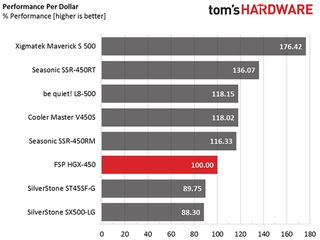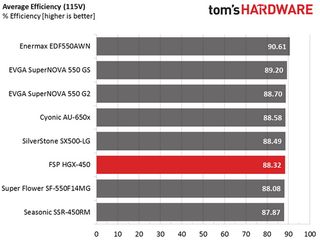FSP Hydro X 450 Power Supply Review
After the Hydro G series, FSP decided to release a more affordable power supply called the Hydro X, which targets systems with lower energy needs. This PSU line consists of three units, and in this review we're testing the entry-level 450W model.
Why you can trust Tom's Hardware
Performance, Performance Per Dollar, Noise and Efficiency Ratings
Performance Rating
The following graph shows the total performance rating of the PSU, comparing it to other units we have tested in the past. To be more specific, the tested unit is shown as 100 percent, and every other unit's performance is shown relative to it.

Performance is good overall, though it's lower than competing Seasonic and Cooler Master PSUs in this category. Better load regulation, along with lower ripple at +12V, would easily bring the HGX450's performance much closer to its rivals.
Performance Per Dollar
The following chart may be the most interesting to many of you because it depicts the unit's performance per dollar score. We looked up the current price of each PSU on popular online shops and used those figures and all relative performance numbers to calculate the index. If the specific model wasn't available in the United States, we searched for it in popular European Union shops, converting the listed price to USD (without VAT). Note that all of the numbers in the following graph are normalized by the rated power of each PSU.

A high MSRP cripples this unit's performance per dollar score. Once it hits the market, we'll have to go back and recalculate using the street price, which should be a lot lower.
Noise Rating
The graph below depicts the cooling fan's average noise over the PSU's operating range, with an ambient temperature between 28 °C and 30 °C (82 °F to 86 °F).

The noise output is low compared to similar-capacity PSUs we've reviewed.
Efficiency Rating
The following graph shows the average efficiency of the PSU throughout its operating range, with an ambient temperature between 28 °C and 30 °C.

Unfortunately, the only other 450W unit we have efficiency data for is Seasonic's SSR-450RM, so we had to compare the HGX450 to higher-capacity PSUs in this graph. FSP's offering lands close to the middle of the pack, outperforming budget-oriented Super Flower and Seasonic power supplies.
Current page: Performance, Performance Per Dollar, Noise and Efficiency Ratings
Prev Page Ripple Measurements Next Page Pros, Cons And Final VerdictStay on the Cutting Edge
Join the experts who read Tom's Hardware for the inside track on enthusiast PC tech news — and have for over 25 years. We'll send breaking news and in-depth reviews of CPUs, GPUs, AI, maker hardware and more straight to your inbox.
Aris Mpitziopoulos is a Contributing Editor at Tom's Hardware US, covering PSUs.
-
powernod ReplyDo Hydro PSUs work underwater?
Yeah, they have to work underwater in order to camouflage themselves from Corsair's (PSUs) who dominate the water's surface!! :p
Or to pass through the Seasonic wall !!:lol:
ONTOPIC: Decent PSU from FSP, but only just decent!!
-
Aris_Mp it is hard to enter the US markets with Corsair and EVGA throwing one model after the other and in very competitive prices, however more variation is always welcome. If they lower significantly the price tags on these models then their marketing career will be easier.Reply
-
Dark Lord of Tech Hard to penetrate the EVGA lineups with their great prices on the higher end units. These need to be lowered to sell.Reply -
turkey3_scratch Is there any reason the 3.3V rail shows strange behavior when crossloading? Not that it's bad or anything, but in CL1 with heavy load on the 3.3V rail, the voltage is about 0.10V higher than CL2, where the 3.3V rail has minimal load, and voltage is typically higher.Reply -
turkey3_scratch Okay, just finished reading the review. Besides the disappointing transient response of this unit, and the failure to meet hold-up time, this is a good unit. But the price needs to drop to about $60 IMO if it wants to compete well. Currently it's priced the same as the Hydro G 650W, and the Hydro G is a no-brainer choice over this unit.Reply
It also concerns me a bit that the 5V rail voltage goes to 4.79V in your second transient response test at 50% load. This is all around also a bit disappointing, but it's not a very realistic transient load (unlike 12V which happens always while gaming), but I like the Japanese capacitors, the load regulation is fine, the crossload graphs all show good results; sometimes a lot of units screw up on those. It's nice to be able to see those different load patterns, something other reviewers should try to adopt. Ripple was very nice. -
joz ReplyHard to penetrate the EVGA lineups with their great prices on the higher end units. These need to be lowered to sell.
G2 is love, G2 is life. (G2 550W, about...eight of them....) -
basroil FSP almost had an excellent PSU until they screwed up big time on the transient response. Looks like the EVGA G2/ SuperFlower Leadex Gold is still king of the inexpensive PSUsReply -
Flying-Q Please stop referring to quality PSUs with low wattage as 'entry 'level' (in the article subtitle).Reply
Entry Level (adjective)
(of a product) suitable for a beginner or first-time user; basic.
"entry-level computers"
'Entry level' usually implies smaller feature set. In this instance the feature set of each of the models is the same other than the power output. Current generation computers need less power due to greater efficiency inherent in more recent designs of components. -
turkey3_scratch Reply17768395 said:FSP almost had an excellent PSU until they screwed up big time on the transient response. Looks like the EVGA G2/ SuperFlower Leadex Gold is still king of the inexpensive PSUs
I would like other testing sites to start adopting these tests, like Jonnyguru. I wonder how many units that normally pass stuff would fail.
Another funny thing is FSP just wrote a blog about the importance of transient response. :P
But also, a 3.3V transient response just doesn't happen in 2016, probably never will. A 5V one is also less common. -
basroil Reply17769266 said:But also, a 3.3V transient response just doesn't happen in 2016, probably never will. A 5V one is also less common.
ATX loading specs state a 9A transient on 12V (and 5V might have been there). Considering most modern PSUs are 12V only and then DC-DC for 3.3 and 5V, 12V transients are going to end up affecting the 5v and 3.3V lines too.
